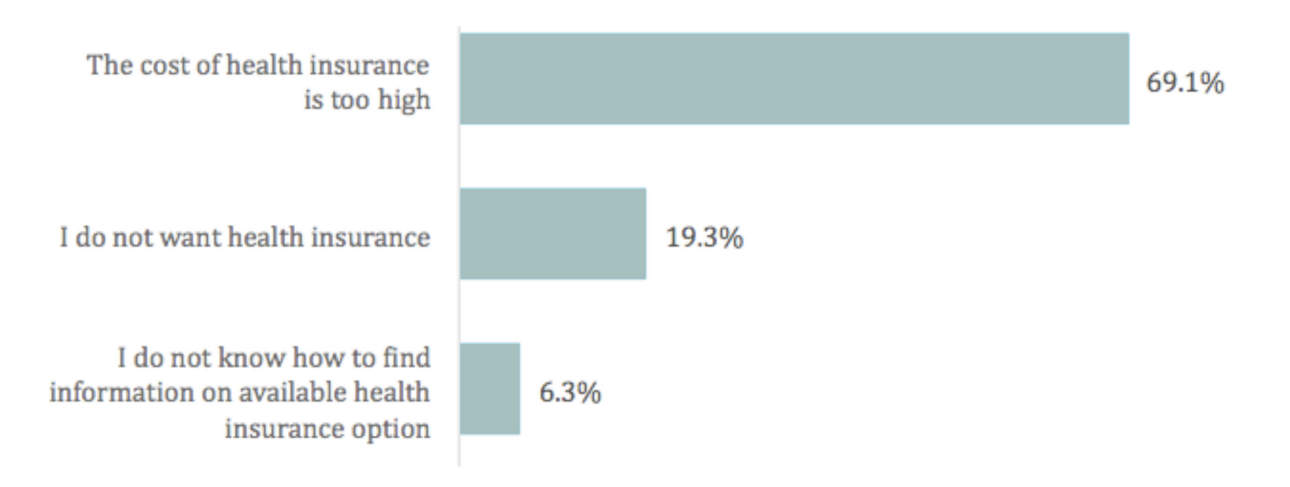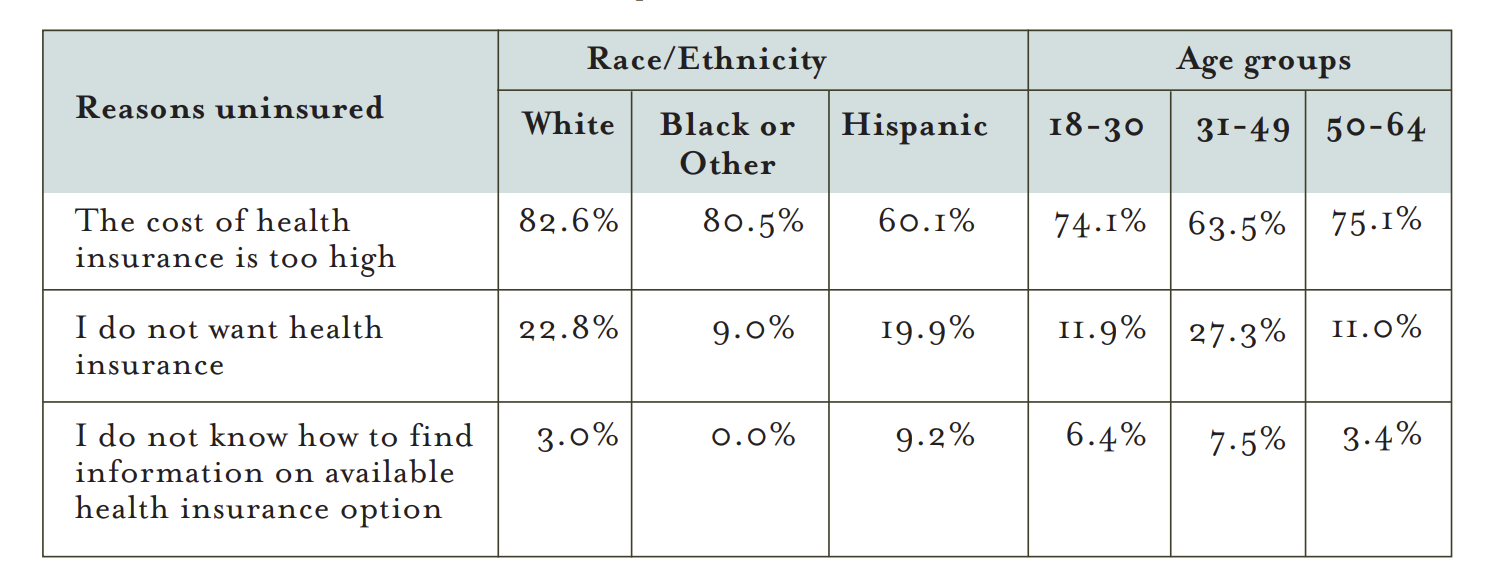HRMS Issue Brief #18: Why Were 20% of Adult Texans Uninsured in 2015?

Table of Contents
Author(s)
Vivian Ho
James A. Baker III Institute Chair in Health EconomicsElena M. Marks
Senior Fellow in Health PolicyShare this Publication
- Download PDF
- Print This Publication
- Cite This Publication Copy Citation
Marks, E., Sim, S., Ho, V., and Balihe, P. James A. Baker III Institute for Public Policy, Rice University, The Episcopal Health Foundation, Health Reform Monitoring Survey – Texas, Issue Brief #18: Why were 20% of Adult Texans Uninsured in 2015?
By Elena Marks, Shao-Chee Sim, Vivian Ho and Philomene Balihe
In September 2015, just before the third open enrollment period of the Affordable Care Act’s (ACA) Health Insurance Marketplace was about to open, we surveyed Texans ages18 to 64 to understand the reasons why the uninsured population remained uninsured two years after the implementation of the ACA's major insurance coverage provisions. We looked as the group of uninsured as a whole and by demographic subgroups including race/ethnicity and age. Our analysis shows that for the full group of uninsured adults, the overwhelming reason cited for remaining uninsured was the cost of health insurance. Comparatively few respondents stated that they were uninsured because they did not want health insurance, and even fewer cited lack of information as a reason.
About the Survey
The Health Reform Monitoring Survey (HRMS) is a quarterly survey of adults ages 18-64 that began in 2013. It is designed to provide timely information on implementation issues under the ACA and to document changes in health insurance coverage and related health outcomes. HRMS provides quarterly data on health insurance coverage, access, use of health care, health care affordability, and self-reported health status. The HRMS was developed by the Urban Institute, conducted by GfK, and jointly funded by the Robert Wood Johnson Foundation, the Ford Foundation, and the Urban Institute. Rice University’s Baker Institute and The Episcopal Health Foundation are partnering to fund and report on key factors about Texans obtained from an expanded, representative sample of Texas residents (HRMS-Texas). The analyses and conclusions based on HRMS-Texas are those of the authors and do not represent the view of the Urban Institute, the Robert Wood Johnson Foundation or the Ford Foundation. Information about the sample demographics of the cohort is available in Issue Brief #1. This Issue Brief is a summary of data extracted from the HRMS Surveys in Texas administered between September 2013 and September 2015. We will continue to report on survey data through additional Issue Briefs and future surveys.
Affordability of Health Insurance Is the Primary Reason Adult Texans Remain Uninsured
As we reported in Issue Brief # 16, in our September 2015 HRMS survey, 18.5% of Texans aged 18 to 64 reported that they were uninsured. We asked those respondents the reasons why they were uninsured and, as shown in Figure 1 below, 69.1% reported that they were uninsured because the cost of insurance was too high. A comparatively small percentage, 19.3, reported that they did not want health insurance; and only 6.3% reported that lack of information on available health insurance was a barrier.
Figure 1 — Reasons Adult Texans Were Uninsured, September 2015

We stratified the respondents by race/ethnicity and age to see if the reasons given for being uninsured differed across groups. As the data show in Table 1, the relative rates at which respondents cited high costs, no desire for insurance, and lack of knowledge as reasons for being uninsured are consistent across all groups. However, there are some notable differences within groups across these three reasons.
Table 1 — Reasons Uninsured by Race/Ethnicity and Age, September 2015

Not surprisingly, the reason cited by the overwhelming majority of every group was that the cost of insurance was too high. While the cost of insurance does not vary by race/ethnicity, it does vary by age. The oldest and youngest groups cited cost as a factor slightly more often than the middle aged group. For the 18-30 year old age group, this may reflect an increase in premiums for the youngest purchasers after the implementation of the ACA’s age band rating rules and/or the fact that overall, young people earn less than older people so that even well-priced insurance plans seem less affordable. With respect to the oldest respondents, their premiums are, on average, higher than their younger counterparts, which would make affordability a more significant issue.
More than one-quarter of the respondents 31-49 years of age reported that they did not want health insurance, more than double the rates of the older and younger cohorts. This group also cited high costs at lower rates than the other two age groups. When considered together, it is possible that the middle aged group’s disinterest in having health insurance muted any concerns they may have had about cost. This same dynamic may be at play among Hispanic respondents: they cited high costs at lower rates than other groups, but also expressed a relatively high rate of disinterest in coverage.
We have a sufficient number of responses to test whether there are differences across broad income categories in the share of uninsured saying the cost of insurance is too high. It may seem paradoxical that those persons in households between 139% and 399% of the FPL were more likely to cite cost as a barrier to health insurance (80.3%) than low income persons in households earning <=138% of the FPL (66.1%). This contradiction may be due to the structure of premium subsidies in the Marketplace. One can use an online calculator to estimate the cost of a health insurance plan for a 30 year old single male living in Houston earning $23,540 (200% of the FPL) in 2016. After federal subsidies, this person can purchase a silver plan for $126 per month and bronze plan for $82. In contrast, a 30 year old single male earning $16,243 (138% of the FPL) can purchase a silver plan for $45 per month and a bronze plan for only $1 per month. As income increases, the federal subsidies for purchasing insurance become less generous, which poses a significant financial challenge to lower middle income persons on a limited budget.
Information About Health Insurance Is Not a Significant Barrier for Adult Texans Who Remain Uninsured
An important finding in this survey is that there is no significant information barrier for adult Texans who remained uninsured. Overall, only 6.3% of uninsured respondents cited a lack of information as a reason for their being uninsured. Among the sub-groups, Hispanics reported the highest rates of lack of information, but only at 9.2% which is well below the rates cited for other reasons (and possibly reflective of language barriers). Data from previous HRMS surveys as well as other sources showed that just two years ago, as the coverage provisions of the ACA were going into effect, lack of information about the law and its coverage opportunities was widespread. In Texas, funding from federal and some local governments, and philanthropy have supported broad and successful efforts to educate the public about the ACA and to enroll more than one million eligible Texans in Marketplace plans. The significant reduction in Texas’ rate of uninsured adults is not surprising in light of these efforts. Texas still has a long road ahead to be able to benefit from ACA coverage opportunities, including Medicaid expansion, which alone would bring more than one million additional Texans health insurance coverage.
Looking Ahead
We will continue to analyze and report on the 2015 data to understand the characteristics and experiences of newly insured Texans and those who remain uninsured. In 2016, we will survey again and gain knowledge about the impact of the third open enrollment period and the experiences of Texans with their Marketplace plans.
Methodology
Each quarter’s HRMS sample of nonelderly adults is drawn from active KnowledgePanel® members to be representative of the US population. In the first quarter of 2013, the HRMS provided an analysis sample of about 3,000 nonelderly (age 18–64) adults. After that, the HRMS sample was expanded to provide analysis samples of roughly 7,500 nonelderly adults, with oversamples added to better track low-income adults and adults in selected state groups based on (1) the potential for gains in insurance coverage in the state under the ACA (as estimated by the Urban Institute’s microsimulation model) and (2) states of specific interest to the HRMS funders.
Although fresh samples are drawn each quarter, the same individuals may be selected for different rounds of the survey. Because each panel member has a unique identifier, it is possible to control for the overlap in samples across quarters.
For surveys based on Internet panels, the overall response rate incorporates the survey completion rate as well as the rates of panel recruitment and panel participation over time. The American Association for Public Opinion Research (AAPOR) cumulative response rate for the HRMS is the product of the panel household recruitment rate, the panel household profile rate, and the HRMS completion rate—roughly 5 percent each quarter.
While low, this response rate does not necessarily imply inaccurate estimates; a survey with a low response rate can still be representative of the sample population, although the risk of nonresponse bias is, of course, higher.
All tabulations from the HRMS are based on weighted estimates. The HRMS weights reflect the probability of sample selection from the KnowledgePanel® and post-stratification to the characteristics of nonelderly adults and children in the United States based on benchmarks from the Current Population Survey and the Pew Hispanic Center Survey. Because the KnowledgePanel® collects in-depth information on panel members, the post-stratification weights can be based on a rich set of measures, including gender, age, race/ethnicity, education, household income, homeownership, Internet access, primary language (English/Spanish), residence in a metropolitan area, and region. Given the many potential sources of bias in survey data in general, and in data from Internet-based surveys in particular, the survey weights for the HRMS likely reduce, but do not eliminate, potential biases.
The design effect for the Texas data in March 2015 is 2.243 and the MOE is +/- 3.7. The survey fielded from September 1-25.


